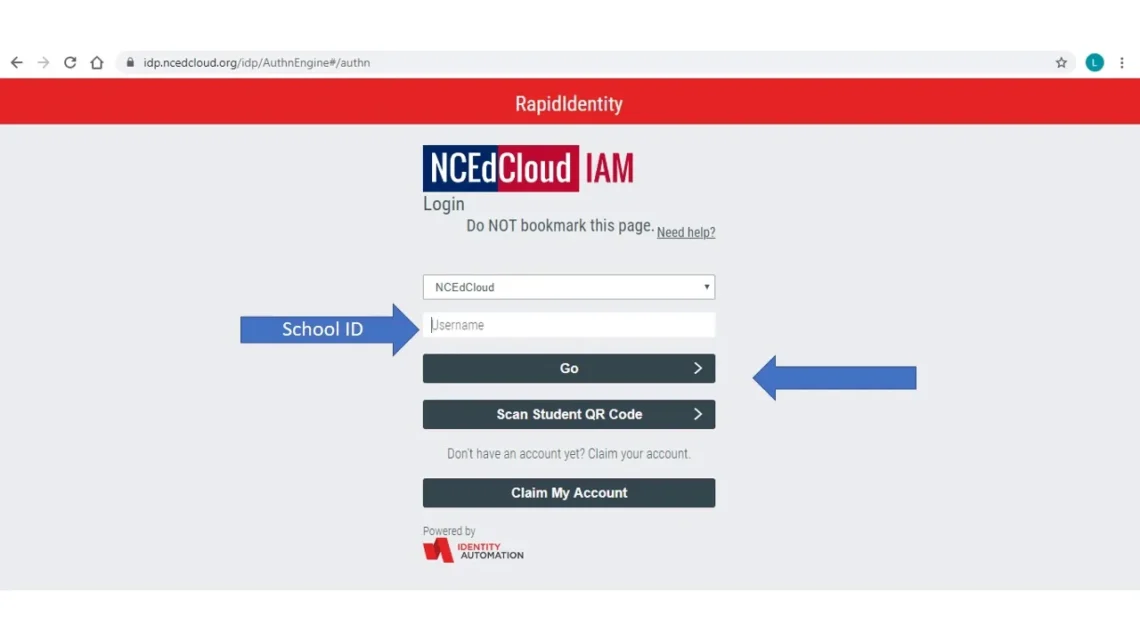NCEdCloud (short for North Carolina Education Cloud) is a centralized Identity and Access Management (IAM) system used by the North Carolina Department of Public Instruction and participating local education agencies (LEAs) and charter schools. Its core function is to provide single sign-on (SSO) access for students, teachers, and staff to educational systems, such as PowerSchool, Home Base, SchoolNet, and other integrated applications.
Rather than maintaining separate usernames and passwords for each system, NCEdCloud lets users log in once and access multiple services. This reduces login friction, improves security, and simplifies account management for schools.
In short, NCEdCloud plays the role of an IAM hub in North Carolina’s public education infrastructure.
How NCEdCloud Works: Architecture & Key Components
To understand NCEdCloud deeply, it helps to break down its architecture and major components.
1. IAM Service / Identity Layer
At its core, NCEdCloud has an IAM service which handles user identity, authentication, and authorization. Users—students, teachers, staff—are given unique identifiers (UIDs) and credentials, and those credentials are validated by the IAM layer for access to downstream systems.
This service supports features like password resets, account recovery, multi-factor authentication (MFA) (depending on settings), and exception roles (e.g. administrative or help desk accounts)
2. Seamless Login / Portal Integration
NCEdCloud supports Seamless Login integrations with local identity providers, such as ClassLink, enabling users to use their local portal credentials to reach NCEdCloud without re-entering credentials.
It also acts as the gateway to target applications—i.e. systems the user needs (PowerSchool, Home Base, etc.). Schools or LEAs integrate those systems with NCEdCloud so that once the user is authenticated, they can be passed through to those services.
3. Account Claiming & Provisioning
New users or first-time users must claim their NCEdCloud account. This involves verifying identity (student number / UID, birthdate, etc.), setting a password, providing security questions, and linking their account to school records.
Local education agencies (LEAs) or schools also coordinate account creation and provisioning so that teachers, staff, or students are correctly mapped into the system.
4. Analytics, Dashboards & Request Modules
Beyond identity, NCEdCloud also offers analytics dashboards and a request module for LEA administrators to manage workflows (e.g. requests for target application access, student badge usage, etc.)
Additionally, there is a knowledge base and training repository hosted under NCEdCloud for both end users and administrators.
Using NCEdCloud as a Student, Teacher, or Staff: Features & Flows
This section walks through how different users interact with NCEdCloud and what they can do with it.
Account Claim & First Login
-
A student must visit my.ncedcloud.org and click “Claim My Account”.
-
They input their student UID (often the PowerSchool number), grade, birthdate, and the LEA code (e.g. “350”) to validate their identity.
-
Then they set a password (meeting criteria like mix of uppercase, lowercase, number, length) and choose several security questions.
-
After that, they may have to confirm via a CAPTCHA or verification step.
Once claimed, that account becomes their central credential to access other services.
Logging In & Single Sign-On
-
After account setup, users log in via NCEdCloud and are presented with a portal or dashboard containing “tiles” or links to target applications (e.g. Home Base, PowerSchool, test systems).
-
They click the desired app, and behind the scenes the system uses SSO / token-based authentication to log them in automatically, without needing to re-enter credentials.
Password Reset & Security Management
-
If a user forgets their password, they can initiate a password reset through NCEdCloud, using their security questions or alternate credentials.
-
Administrators (or help desk roles) can also assist in resetting or regenerating default passwords, especially at the start of a school year.
Administrative / Privileged Roles
-
LEA administrators and school IT staff have exception roles in NCEdCloud that allow them to manage user accounts, approve access to target applications, adjust security policies, and handle requests.
-
They may use tools like the Request Module to route and approve workflows (e.g. granting access, opting out of student badges).
Benefits & Challenges of NCEdCloud Adoption
Deploying and using NCEdCloud brings various advantages as well as some potential challenges.
Benefits
-
Enhanced Security & Central Control
With one identity layer, policies such as password complexity, account locking, multi-factor authentication, and role-based permissions can be enforced centrally rather than in each disconnected system. -
Single Sign-On (SSO) Convenience
Users only need to remember one credential, reducing password fatigue and lowering support time spent on login issues. -
Streamlined User Provisioning
New accounts can be created, claimed, and managed from one system, reducing duplication and inconsistencies across systems. -
Reduced Administrative Overhead
Because identity and application access are managed centrally, local IT and help desk support load is reduced, and changes (e.g. granting access) become easier. -
Scalability for Integrations
When new educational software or applications are adopted, integrating them into NCEdCloud enables smooth access for users without separate credential systems.
Challenges & Risks
-
High Initial Integration Effort
Each target application (PowerSchool, Home Base, etc.) must be integrated properly with NCEdCloud, which requires coordination, configuration, and testing. -
User Onboarding & Education
Students, teachers, and staff must learn the new workflow (claim account, use SSO) and deal with issues like forgotten passwords or failed claims. -
Dependency Risks
If NCEdCloud experiences downtime or issues, access to all integrated systems can be affected, making resilience and reliability critical. -
Security Risks
Because it is a central IAM hub, any breach or vulnerability in NCEdCloud would have wide impact across many educational systems. Proper security controls, audits, and incident response are essential. -
Data Synchronization & Accuracy
The identity data (student records, staff records) must be synchronized accurately from authoritative sources (e.g. PowerSchool) to avoid mismatches, stale records, or access errors. -
Scalability & Performance
As usage scales (thousands of students logging in simultaneously), performance must be robust to avoid slowdowns or failures during peak times.
Best Practices & Tips for Schools & Users
In order to get the most out of NCEdCloud, here are recommended practices for institutions and individual users.
For Schools / LEAs
-
Plan Integration Carefully: Create a roadmap for integrating each target application gradually, testing thoroughly before full rollout.
-
Adopt Redundancy & Monitoring: Monitor system health, have fallback plans, and ensure failover capabilities so that the IAM system does not become a single point of failure.
-
Provide Training & Documentation: Build guides, training sessions, and FAQs for students, teachers, and staff on how to claim accounts, reset passwords, and access applications.
-
Enforce Strong Security Policies: Use password complexity, account lockouts, multi-factor authentication (where possible), and periodic audits of privileged accounts.
-
Manage Data Pipeline: Ensure the student/staff data source (PowerSchool or local SIS) feeds into NCEd Cloud correctly, with consistent UIDs, naming conventions, and updates.
-
Use the Request Module: Leverage the built-in request workflows so that granting, revoking, or modifying application access follows audited, approved steps.
For Users (Students, Teachers, Staff)
-
Remember Your UID & Setup Info: The student or staff UID (PowerSchool number) is key to claiming and logging in. Keep it safe.
-
Choose a Strong Password: Use the policy guidelines (mix of letters, numbers, no spaces, etc.). Don’t reuse easily guessed words.
-
Answer Security Questions Thoughtfully: Choose questions whose answers you’ll remember reliably but are hard for others to guess.
-
Bookmark the NCEdCloud Portal: Use the official portal (my.ncedcloud.org) to access application links rather than managing many separate logins.
-
If You Forget Password, Use Self-Service Tools: Use the password reset or recovery workflows in NCEd Cloud before contacting IT support.
-
Report Issues Immediately: If you can’t login to multiple applications, the problem may lie in NCEdCloud itself—inform your school’s IT/help desk early.
Future Outlook & Enhancements for NCEdCloud
As educational technology continues to evolve, NCEdCloud itself is likely to see further enhancements and changes. Below are some trends and possible future directions.
Greater Adoption of Seamless Login / Federated Identity
Integration with identity systems like ClassLink has been introduced as “Seamless Login” options, allowing local portal credentials to interface directly with NCEdCloud. It’s likely this trend will be expanded, making login even smoother and more federated.
More Applications & Ecosystem Expansion
As schools adopt new EdTech tools (learning management systems, assessment platforms, content repositories), support for those via NCEd Cloud will grow. This means more “target applications” will join the ecosystem.
Strengthened Security Features
We can expect enhancements such as adaptive authentication (based on user behavior), stronger multi-factor authentication (e.g. push notifications, hardware tokens), and continuous monitoring.
Analytics, Reporting, and Usage Insights
NCEdCloud’s dashboards may evolve to provide richer analytics, e.g. usage trends by school, application adoption metrics, login patterns, and security event reporting.
Mobile / App Experience
While currently NCEd Cloud is mostly web-based, future improvements could bring dedicated mobile apps or more mobile-friendly UI to streamline access on phones and tablets.
High Availability, Redundancy & Disaster Recovery
To mitigate risks of central IAM outages, enhancements around redundancy, load balancing, and failover infrastructures will likely continue to be invested in.
Conclusion
NCEdCloud stands as a foundational piece of technology in North Carolina’s education system, functioning as a unified Identity and Access Management (IAM) hub that simplifies how students, teachers, and staff access essential educational systems. By enabling single sign-on (SSO), centralizing account management, and integrating with applications like PowerSchool and Home Base, NCEd Cloud reduces complexity, improves security, and streamlines IT administration.
However, the system is not without challenges: the need for careful integration, risk management, user education, and ensuring system reliability are all critical. Proper planning, robust security policies, training, and redundancy are key to making NCEd Cloud a reliable backbone for digital education.
Looking forward, we can anticipate more seamless login options, expanded application support, stronger security features, richer analytics, and improved user experience. For North Carolina’s educational stakeholders—districts, schools, IT teams, and end users—NCEdCloud promises to be an evolving platform that helps modernize and secure the digital education ecosystem.





